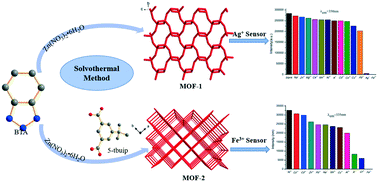Luminescent MOFs for selective sensing of Ag+ and other ions (Fe(iii) and Cr(vi)) in aqueous solution†
Abstract
Two new title MOFs, [Zn(BTA)2]n (LMOF-1) and [Zn3(BTA)2(5-tbuip)2]n (LMOF-2) (BTA = 1H-benzotriazole, 5-tbuip = 5-tert-butylisophthalic acid), have been synthesized by a solvothermal method. The structures of the two complexes have been determined by single-crystal X-ray diffraction analysis and further characterized by elemental analysis, IR spectroscopy, powder X-ray diffraction (PXRD) and thermogravimetric (TG) analysis. And the calculation of PLATON displays that the porosity values are 15.04% and 18.77%. Fluorescence analysis reveals that the two MOFs generate strong blue luminescence; LMOF-1 and LMOF-2 can be regarded as multiresponsive fluorescence sensors for Fe(III) and Cr(VI) (CrO42−/Cr2O72− ions) detection with high sensitivity and selectivity and a low detection limit in water via fluorescence quenching. It is worth noting that most LMOFs for detecting Ag+ to date are mainly formed with rare earth lanthanide metals, while there are still few Zn-based LMOF probes used in Ag+ detection. LMOF-1 can detect trace Ag+ in water with a low detection limit. In addition, LMOF-1 has excellent water stability and thermal stability, and is an excellent material for detecting Ag+ in daily water samples.



 Please wait while we load your content...
Please wait while we load your content...